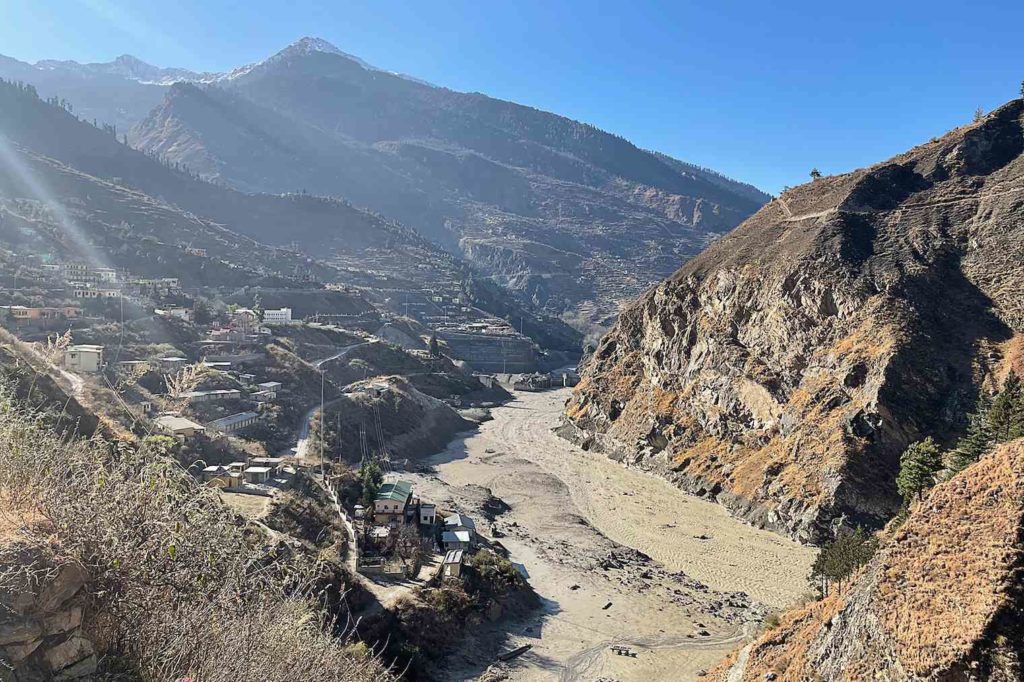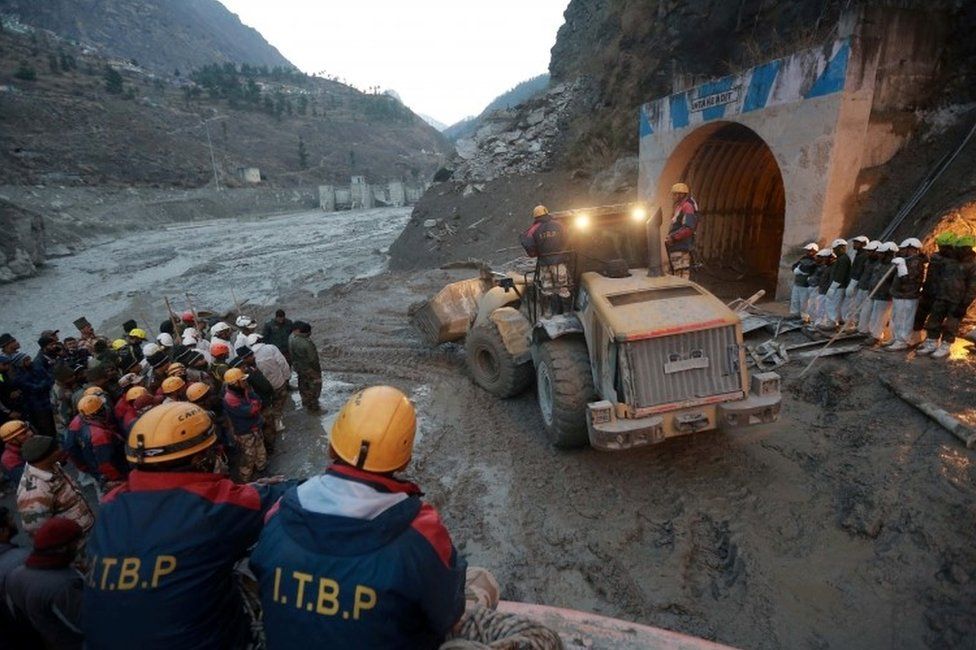International Rivers expresses our sorrow and regret over the tragic loss of life and destruction in a disastrous flash flood affecting the Chamoli district and other parts of India’s Uttarakhand state on 7 February 2021. A wall of water and debris swept through the Himalayan valley and overtopped two hydropower dams, leaving at least 175 people missing and 31 feared dead. Local activists fear that additional people, such as informal labourers at dam construction sites, may be unaccounted for.
India’s national crisis management committee (NCMC) has stated that the flood was caused by a mountain glacier partially breaking off into the Rishiganga river, promoting a dramatic rush of water. Some experts have linked the incident, occurring during the cold season, to an escalating climate crisis, with Himalayan glaciers melting at faster rates than previously predicted. Subsequent analysis has pinned the cause on an avalanche or landslide rather than a glacial break — events that are expected to increase in frequency in the region due to climate change.
What is clear is that construction of dams and other mega-infrastructure in the ecologically sensitive Himalayas and in close proximity to the region’s glaciers exacerbates the risks of disaster.

Matu Jansangthan, a local people’s movement, has been voicing concerns over dam-building in Uttarakhand for decades. Vimal Bhai, a local activist from the group, says: “The blame seems to be put squarely on nature for this incident. The news of breaking glaciers is being widely publicized but there is no statement or discussion on the delicate ecology of the Himalayas when granting permission for large projects. The subsequent use of uncontrolled explosives, cutting down of forests, and complete disregard for environmental laws and regulations are swept under the carpet”.
The tragedy is not without precedent or warning. In June 2013, a multi-day cloudburst caused massive floods and landslides in Uttarakhand, killing around 6,000 people in what became known as the Kedarnath disaster. The ‘Chopra’ Committee, formed by the Indian Supreme Court to study the disaster, found that construction of hydropower dams contributed to the severity of the incident. The Supreme Court subsequently ordered that no new hydroelectric plants be constructed in Uttarakhand’s paraglacial regions.
The warnings were not heeded and planned dams have proceeded. As of 2018, there were 37 hydropower projects under operation in Uttarakhand with a total installed capacity of 3971 MW. The National Hydroelectric Power Corporation (NHPC) website lists two additional projects (150 and 195MW) now awaiting clearances and a 630 MW project under survey and investigation. In a response to Sunday’s disaster, Uma Bharti, a former minister for water resources and river development stated that she had warned against placing hydroelectric projects on the river so close to the Himalayan glaciers.
Activists like Vimal Bhai have warned for years that large hydropower projects and the associated destruction of forests and landscapes will have irreversible damage on this fragile ecosystem. The government seems not to have learnt any lessons from the Kedarnath disaster of 2013. The Ministry of Environment and Supreme Court are yet to take concrete steps to ensure that such tragedies are not repeated.
In International Rivers’ work around the world, we have seen time and time again that hydropower dams and other mega-infrastructure projects are frequently constructed with weak or nonexistent impact assessments, haphazard planning and approvals that do not take account of existing projects and wider ecological conditions, and without the input or consent of local people. When disaster strikes, from the horrific collapse of the Xe-Pian Xe-Namnoy Hydropower Project in Laos in 2018 to the tragic failure of the Sardoba dam in Uzbekistan in 2020 – it is local people and ecologies that are placed in harm’s way, while accountability from decision-makers and those profiting from construction remains elusive.
Dam contributions to climate change
Large dams are significant contributors to climate change. Researchers have found that the dams emit far more greenhouse gases into our atmosphere than official reports acknowledge. Studies show that they destroy carbon sinks in wetlands and oceans, deprive ecosystems of nutrients, destroy habitats, increase sea levels, waste water and displace poor communities. Dam reservoirs account for about four percent of human-induced climate change.
Costs and impacts on local communities
In addition to harming ecosystems, dams and other mega infrastructure projects adversely affect local communities. This is true even in the absence of catastrophes like this week’s tragic floods in Uttarakhand. Where disasters do occur, much focus is given to identifying the “natural” causes, whereas in reality, the contributors producing a disaster are significantly more complex than can be captured in a news headline. The media narrative must refocus from “natural” disasters to tell the deeper story of “social and political” disasters.
This tragedy highlights the urgent need to consider and address the impacts and ongoing risks for local communities and the resilience of their immediate environment. We must pause and think critically to safeguard those at most vulnerable to harm when considering new large-scale dam projects. There should be an informed decision and consent process, with decision-makers and developers working closely with local communities. Long-term and cumulative impact assessments are needed to better understand how infrastructure projects can be designed in a way that is resilient, provides long-term benefits, and avoids harm to people and fragile ecosystems. The threat posed by climate change to mega-infrastructure and community well-being must be central within the assessments and decisions taken on such projects.
More Information
- Uttarakhand floods: ‘Disasters happen when we do something stupid’
- The spotlight falls on risks posed by power projects
- Uttarakhand flash floods Live updates: Death toll rises to 31
- Why We Already Know the Rishi Ganga Flood Was a ‘Sooner or Later’ Event
- Statement on the disaster by local organization – Matu Jansangthan
Featured Image: Rescue teams from the Indo-Tibetan Border Police at the tunnels await instructions before going deep into the mountains to rescue construction workers trapped inside. February 09, 2021 Photo Credit: Reuters.

